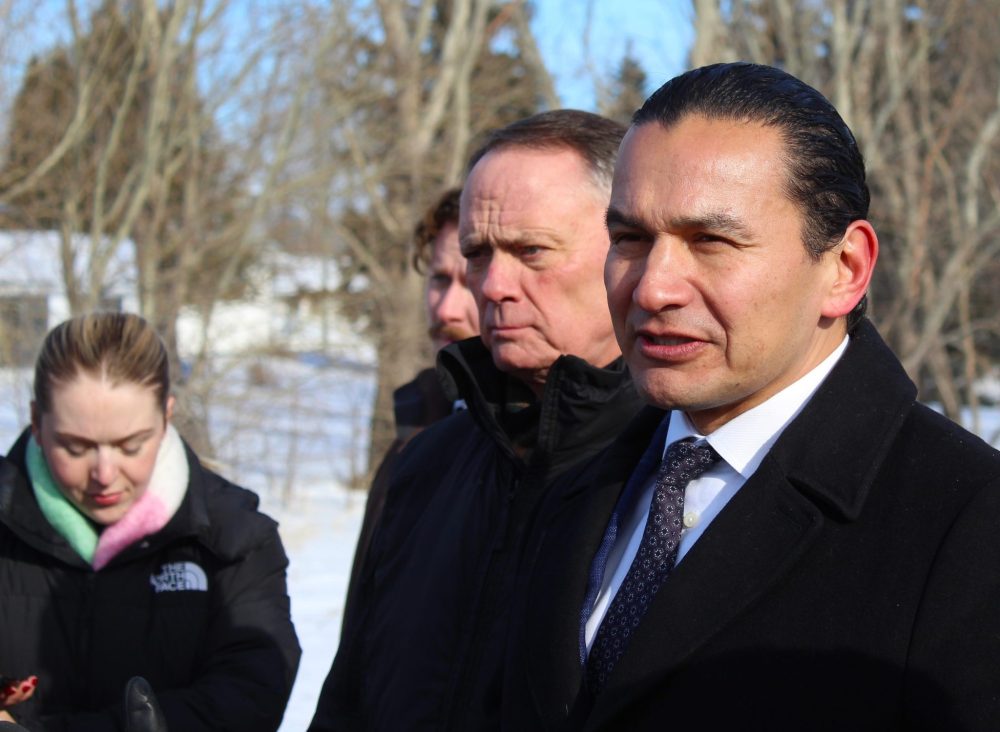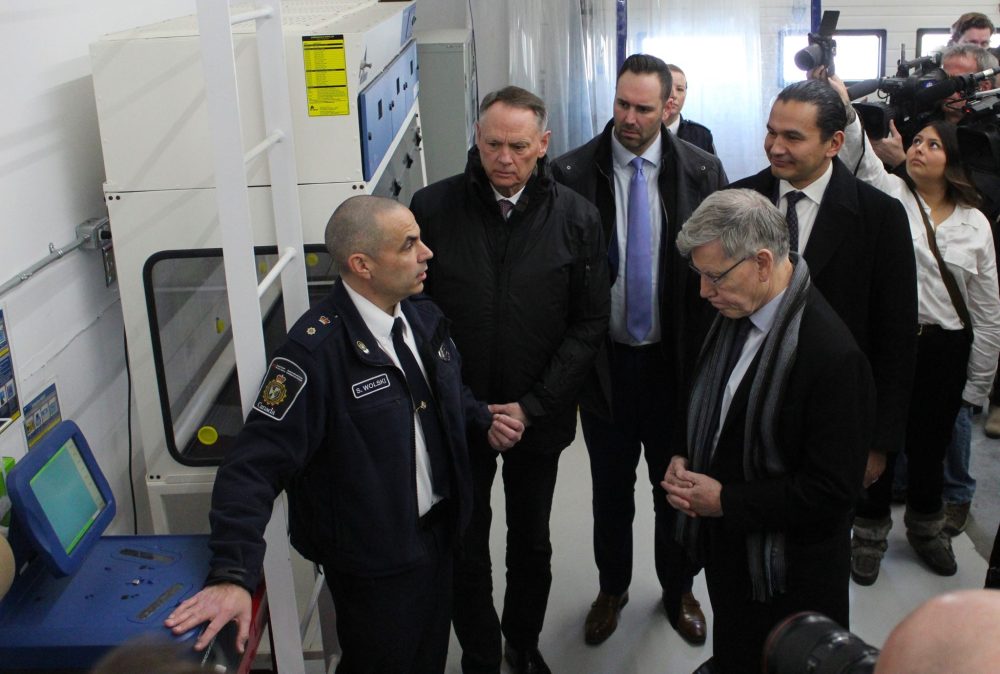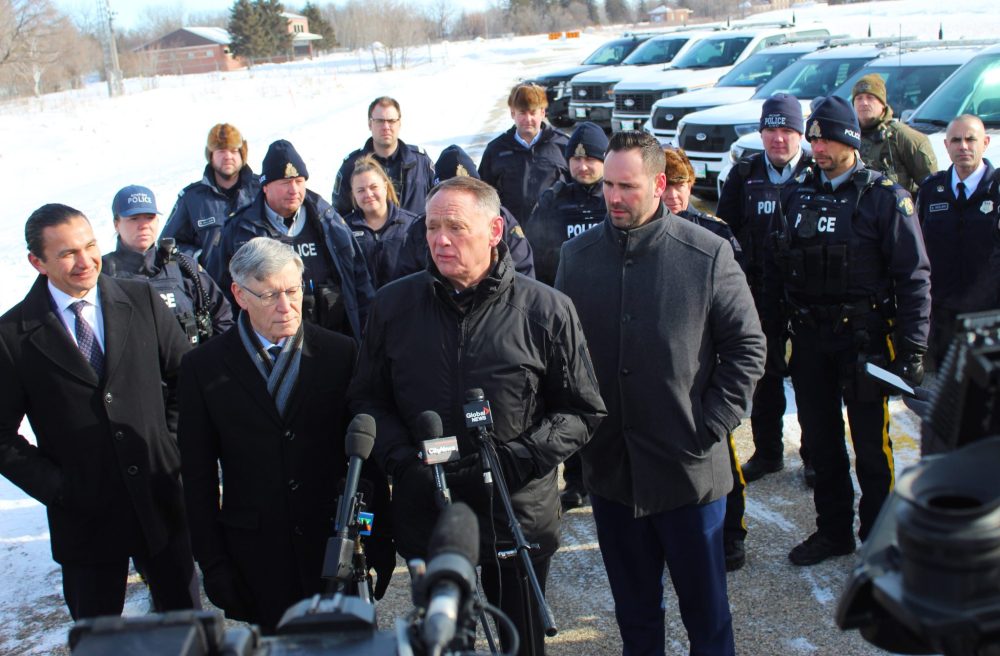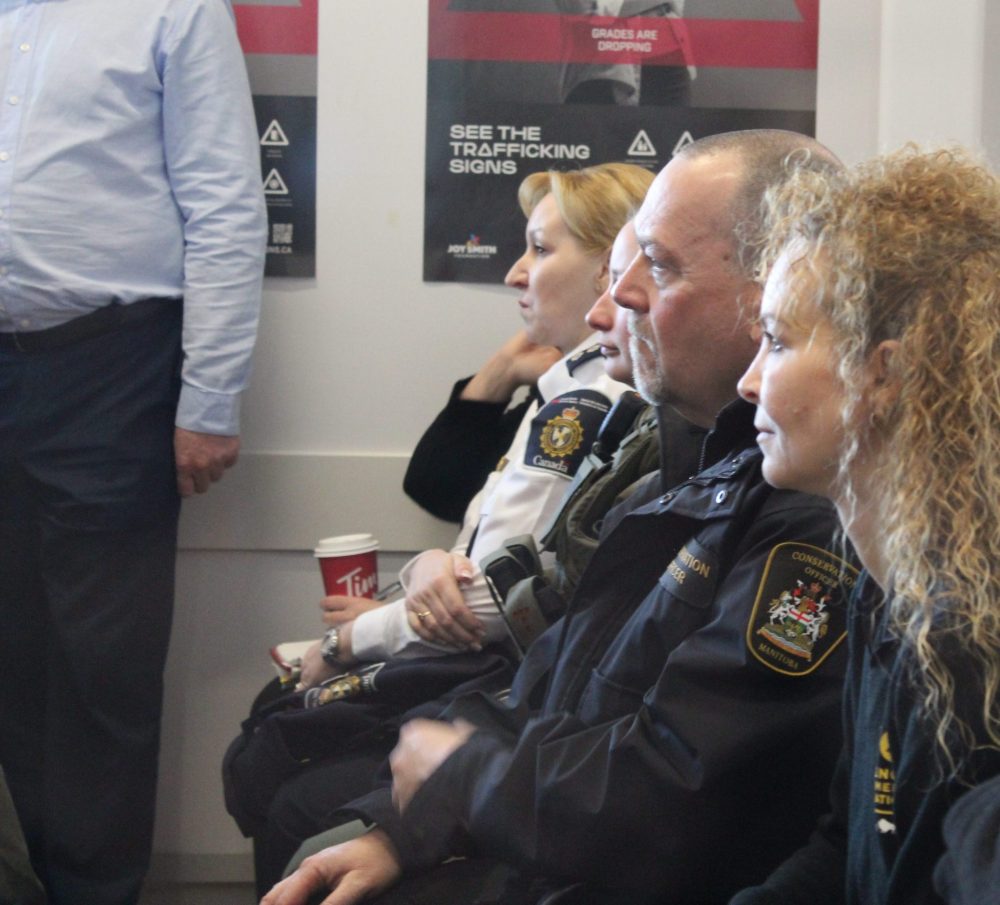Canada touts border security at Emerson crossing after 30-day tariff reprieve
Advertisement
Dozens of personnel from the RCMP, Manitoba Conservation, Canada Border Services, and Manitoba First Nations Police Service joined a couple agents from the U.S. Border Patrol in a show of security at the Emerson border crossing Tuesday.
They were there for a visit from Canada’s Public Safety Minister David McGuinty who was there on a day when 25 percent tariffs from U.S. President Donald Trump were scheduled to hit Canadians. That was put on hold for 30 days by Trump who acknowledged the $1.3 billion border security upgrades Canada announced in December and other measure including a “fentanyl czar” who is to work with Americans to combat organized crime in the drug trade.
Canada’s federal government also agreed to list “organized crime cartels” as terrorists under the Criminal Code; launch a Canada-U.S. joint strike force to combat organized crime, fentanyl and money laundering; spend $200 million to gather intelligence on transnational organized crime to be shared with Americans; and ensure “24/7 eyes on the border through round-the-clock surveillance and by mobilizing law enforcement and civilian forces with new and modernized equipment.”

Premier Wab Kinew and a slew of media from Canada and the U.S. were also there to witness a demonstration of the Emerson crossing’s new Black Hawk helicopter that was part of the $1.3 billion. An RCMP spokesperson said it was unavailable Tuesday for reasons “out of our control,” but that it was still operational.
Who will guard the border?
The new money is to also purchase drones, mobile surveillance towers, more personnel and canine teams. The federal government said in a media statement that there are now nearly 10,000 frontline personnel working to protect the border.
When asked in French, McGuinty dismissed the idea that there was a shortage of people to staff the increased demand. The RCMP last week asked members from across the country to help with the staff shortage in Manitoba.
McGuinty also responded in French that he disagreed with Conservative leader Pierre Poilievre’s suggestion that Canada send military troops to the border to help. In its deal to hold off tariffs against its country, Mexico agreed to send 10,000 troops to its border.
Premier Kinew announced Jan. 27 that Manitoba Conservation officers are now patrolling the border, including those from Steinbach and Sprague. They are patrolling areas between ports of entry with a focus on secondary roads and backcountry areas to spot illegal border crossings, drug trafficking and firearm smuggling into the province. They will call in RCMP for assistance when needed, though they do have full peace officer authority.
“When we make investments here in Manitoba, it’s because we want to see a crackdown on fentanyl in our commuinities. When we have a secure border, that benefits people in our province and in our country.
“And if we make those investments in a time that it helps with our relationship with the U.S., then all the better. They’re our closest ally and our largest trading partner,” said Kinew.
“The only time we should be cheering for different teams is when we’re at the Four Nations Cup and watching hockey. The rest of the time, we should all be friends off the ice. And this investment here on a very icy part of the border is a great sign of how the U.S. and Canada can work together.”
The province is deploying equipment including snowmobiles, utility terrain vehicles and helicopters to support the conservation service’s work patrolling the border. Kinew also said in December that RCMP in Manitoba would be paid overtime to help patrol the border.

“We’ve got to have eyes on our entire border 24/7. And the only way we’re going to do that is by working together; working together with the federal government in Canada, the provincial government here in Manitoba and of course with our friends in the United States of America,” said Kinew.
What are they looking for?
American media from ABC News asked McGuinty how much fentanyl came to the U.S. from Canada, as that was Trump’s most repeated reason for the tariff threat.
“Less than one percent of fentanyl enters the United States coming from Canada. In a 12-month period last year, 43 pounds of fentanyl was apprehended by American authorities crossing into the United States from Canada — 43 pounds. During that same 12-month period 21,000 pounds were apprehended coming in from the southern border,” responded McGuinty.
He added that fentanyl is a scourge across North America, and did point to the fact busting drug labs is something the RCMP already does.
“I’m really proud of the fact that the RCMP over the last six years has actually found and disbanded 47 fentanyl labs, including the largest fentanyl super lab in Canadian history where they found 95,500,000 lethal doses of fentanyl,” said McGuinty.
He added that what the fentanyl czar will specifically do and who they are looking to fill the role should be answered by the end of this week.
Naming drug cartels terrorists is supposed to help police and whoever is the new czar.
“The designation of cartels as terrorists under the Criminal Code is going to give us additional powers to effectively, in really simple English and the language of others, follow the money.

“It’s going to be giving our government, law enforcement authorities more power to exercise, to track the money, to follow the assets, and disrupt the activities of cartels,” said McGuinty.
He, Kinew, and others were given a demonstration of a machine used to detect trace amounts of chemicals including fentanyl. The machine was not new, but was used to emphasize that border guards are already looking for drugs.
In the case of the Canadian border guards, they look for drugs smuggled into Canada. U.S. border guards watch what is coming their way.
Coordination is important when those guards on either side of the border see suspected human smuggling or anyone trying to cross at undesignated spots.
People have died in the winter the last few years trying to cross the border. A family of four from India, including an 11-year-old girl and three-year-old boy, froze in January 2022 near Emerson trying to cross into the U.S. An American federal court was told the alleged smugglers on the American side told the family to turn around and head back to Canada when they called for help. The family was found by Canadian police in a field 12 metres from the border.
Two people from Ghana lost fingers to frostbite trying to cross the border in 2017.
This January, six people from Jordan, Sudan, Chad and Mauritania were stopped trying to cross the border on foot near Emerson. RCMP said they were not dressed for the harsh Manitoba winter and an ambulance was called to help.
Who was this for?
With the clock ticking on the delayed tariff threat that economists predict would put Canada in a recession, McGuinty was asked if the audience for Tuesday’s demonstration was for one person: American President Donald Trump.
“I would say that would be the wrong interpretation.

“I think the interpretation for today is that Canadians should know that we have a very strong border, that we’re making it stronger.
“Canadians should know that we’re cooperating between different orders of government. Canadians should know that their efforts to stand up and protect Canada are not in vain.
“Canadians should know that our relationship with the United States is strong. Canadians should understand that our economies are connected,” responded McGuinty.
President Trump made it clear negotiations are not over for him.
“You know, we’re not treated well by Canada. And we have to be treated well,” said Trump from the White House after announcing the 30-day pause.
“We don’t need them to make our cars; we don’t need them to give us lumber; we don’t need them for agricultural products because we have all the agriculture we need,” he added.
